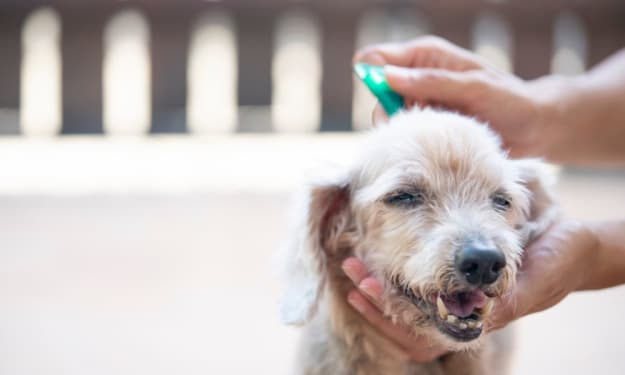12 Methods for making Your Canine More astute and More joyful
Master tips to support your canine state of mind and draw in their psyche

Stressed your canine might be exhausted or not learning enough? Follow these tips to help their temperament and keep them locked in.
#1 Permit your canine chance to pause and smell. Your canine "sees" the world to a great extent through his olfactory faculties. The piece of the canine's cerebrum liable for handling fragrance is roughly 40% bigger than a human's is. Also, they have up to 300 million aroma receptors, contrasted with our similarly insignificant 6,000,000. Strolls aren't just about actual activity, they're about mental feeling as well.
#2 Get to know each other. For the good of both of you, don't spend your strolls on autopilot — or on your telephone. A 2019 study dispatched by Forthglade Regular Pet Food tracked down that close to 66% of U.K. canine proprietors couldn't turn off from screen time while on canine strolls. The study of 1,500 canine individuals found that 63% consistently utilize their telephone while out on canine strolls to send messages (50%), visit with companions (48%), browse work messages (27%), post via virtual entertainment (26%), shop on the web (14%), and even utilize web based dating applications (7%). All things being equal, take part in a care work on, zeroing in on the sights and sounds on your walk. Time in nature has been displayed to work on your temperament — however provided that you're adequately available to receive the rewards. A review revealed in the Diary of Ecological Brain science carved out that opportunity in nature possibly predicts prosperity when people are likewise sincerely sensitive to nature's magnificence.
⇒ Master Tip: Leave your telephone at home. Assuming that your canine is excessively fired up, pulling or woofing, bring some high prize treats and shut down each couple of speeds to request a way of behaving, even a "sit." This will assist your canine with drawing in his cerebrum and center his energy rather than simply charging ahead. It's the excursion, not the objective, all things considered.
#3 Investigate new courses — even only one block over gives new sights and fragrances.
⇒ Genius Tip: You don't have to wander far. Walk a similar course yet set out toward the path you regularly finish in. Or on the other hand just change to the opposite side of the road. Indeed, even minuscule changes permit us to be more receptive to our environmental elements and along these lines more present, while giving new landscape to our puppies.
#4 Sets words with dependable results. There's a valid justification your canine knows "treat," "walk," and maybe even "cheddar" — they generally bring about a similar result (i.e., being given a treat or gone for a stroll). Extend your canine's jargon by dependably matching more words with results. A couple to attempt: "vehicle," "sleep time," and even expressions like, "Would you like to come?"
#5 Continue to prepare meetings fun — and short. The typical grown-up canine can stay centered for as long as 30 minutes all at once, says Stanley Coren, Brain science Teacher, neuropsychological scientist, and author on the insight, mental capacities, and history of canines. For young doggies, that drops to under a moment. "At close to a half year, a doggy can hold center around something fascinating for 30 to 45 seconds before center meanders," says Coren. "They might return to zero in on similar circumstance after break of 20 to 30 seconds."
#6 Show names for toys. Reiteration is the key here. Present a couple toys by name and prize for effectively recovery. However, for most canines this take standard practice, "gifted" canines learn new words in the wake of hearing them only multiple times, a new report has found. "Such quick learning is like the manner in which kids get jargon, around age a few," says the co-creator of the review. The scientists noticed that canines ready to become familiar with the name of their new toy after hearing it only multiple times while playing with their proprietors were restricted to a chosen handful "virtuoso" canines. For every other person, with training and customary redundancy most canines can be prepared to recover some toys by name.
#7 Talk the flattery. It's not exactly what you say, it's the means by which you say it. Turns out there's a valid justification a significant number of us default to child talk with our puppies. X-ray studies have shown that canines answer best to cheerful, sharp sounding tones, like those as often as possible utilized with kids or canine coordinated discourse (child talk).
#8 Take a stab at talking buttons. Christina Craving and her canine Stella created an uproar when recordings of Stella "talking" by utilizing buttons that say words turned into a web sensation. Stella currently knows in excess of 45 words and can join them into expressions to convey. Need to begin? Peruse the article for a question and answer with Yearning.
#9 Use hand signals. Canines are visual students. On the off chance that you don't as of now, begin matching orders, for example, "sit" or "rests," with an unmistakable hand movement, for example, a vertical movement with your hand for "sit" or your arm held in the air for "rests." Be reliable with your signals — consistently utilize similar words/motions.
#10 Show your canine stunts. "Some of the time excused as trivial or senseless, stunts are really an extraordinary method for making everyday preparation with our canines both tomfoolery and dynamic," says Sassafras Lowrey, CTDI (Guaranteed Stunt Canine Teacher) and creator of Stunts In The City. "With choices that are protected and ideal for canines of any age and sizes, stunt preparing is an exceptionally versatile and open action. Indeed, even a cutthroat game with titles can be procured by means of video with the American Pet hotel Club, the Canadian Pet hotel Club and associations like Accomplish More With Your Canine. Stunt preparing makes learning fun and gives a magnificent chance to fortify associations with our canines. What's more, stunt preparing is a magnificent method for building certainty for the two canines and individuals.
"While beginning with stunts, work with your canine's assets and the things you as of now partake in doing together," she proceeds. "In the event that your canine appreciates digging and pawing, showing high 5, wave or shake can be an extraordinary spot to begin. On the off chance that you have an awesome time fixated canine, stunts like tidying up their toys or playing b-ball or soccer can be fun stunts to pursue."
#11 Make them work for their food. Most canines are massively food persuaded. Exploit this to look out for some way to improve on abilities your canine has proactively dominated, as sit or down-stay.
About the Creator
Ridybash
I am a freelancer, content creator, YouTuber so kindly subscribe to my channel
https://www.youtube.com/channel/UCCF2YuRju-a4mgWew3OQt9g/featured
Enjoyed the story? Support the Creator.
Subscribe for free to receive all their stories in your feed. You could also pledge your support or give them a one-off tip, letting them know you appreciate their work.






Comments (1)
Great